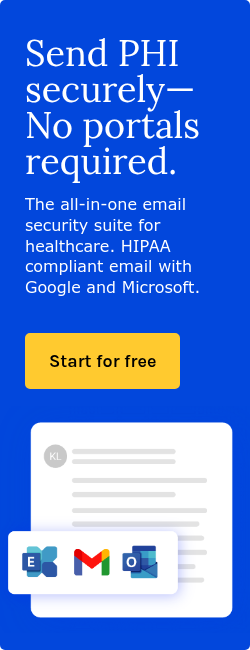
When people search for information about HIPAA, they’re often met with headlines about violations, fines, and enforcement actions. And while those stories offer valuable lessons, they can also obscure the many examples of organizations quietly and consistently getting HIPAA compliance right. These examples matter just as much, if not more, because they demonstrate what’s possible when privacy is prioritized and HIPAA rules are taken seriously.
From thoughtful workplace design to carefully worded policies, compliance doesn’t have to be complicated or reactive. Sometimes it’s simply about making good choices consistently.
Responding to online reviews without violating privacy
In 2019, a Dallas-based dental practice, Elite Dental Associates, paid $10,000 to settle a HIPAA violation after publicly responding to a negative online review by disclosing details about the patient’s care. Despite the clear warning this case provided, similar violations continued to surface. In 2022 alone, two dental offices were fined $23,000 and $50,000 for responding to online comments in ways that exposed protected health information (PHI).
Not every dental practice slips up when handling criticism online. Many practices know not to expose patient information. When these organizations get a negative comment, they don’t jump into defense mode on Facebook or Instagram. Instead, they reach out privately to see what went wrong and how the issue can be rectified. It’s a smart move that keeps the conversation human and compliant. Rather than getting tangled in public back-and-forth, they stay professional, protect trust, and avoid unnecessary legal headaches.
Creating spaces that protect patient privacy
Walk into any well-designed pharmacy, and you may notice a quiet room off to the side—a private consultation space where patients can speak with pharmacists confidentially. It’s a feature you might take for granted, but it’s also a perfect example of HIPAA compliance in action.
These consulting rooms help reduce the risk of sensitive conversations being overheard in crowded waiting areas or at the pharmacy counter. According to a study published in the International Journal of Pharmacy Practice, both pharmacists and patients support the use of private consultation areas to ensure privacy during sensitive discussions. They also enhance patient care by allowing interactions with fewer distractions. Certain pharmacies make a point of offering these one-on-one sessions, encouraging patients to ask questions about medications or health conditions in a secure setting.
While the HIPAA Privacy Rule doesn’t mandate private consultation rooms, their presence goes above and beyond basic compliance. They signal to patients that their privacy matters and demonstrate a proactive approach to reducing the likelihood of impermissible disclosures of PHI.
Making internal policies transparent and accessible
HIPAA doesn’t require organizations to make their privacy policies publicly available, but when they do, it helps foster a culture of accountability. Some healthcare organizations go a step further by not only publishing these documents but also providing clear explanations about why the policies exist.
The University of Wisconsin-Madison offers a great example. Its policy on email communication involving PHI (Policy UW-129) doesn’t just outline technical rules; it explains the rationale behind them. The policy describes how unencrypted email introduces specific risks to patient confidentiality and outlines the necessity of safeguarding sensitive information in all digital communications.
The policy isn’t just a document collecting dust on an internal drive. It’s built into the university’s HIPAA training and reinforced with examples and best practices. Connecting policy to purpose helps UW-Madison’s workforce understand that compliance isn’t just about rules—it’s about protecting people.
Elevating standards through better privacy notices
One of HIPAA’s core requirements is that covered entities provide patients with a Notice of Privacy Practices (NPP). According to the HHS, “Your health care provider and health plan must give you a notice that tells you how they may use and share your health information. It must also include your health privacy rights. In most cases, you should receive the notice on your first visit to a provider or in the mail from your health plan. You can also ask for a copy at any time.” The full document outlines how a patient’s health information may be used and shared, and what rights they have under HIPAA. While the regulation sets minimum content requirements, some organizations go further, crafting more comprehensive and accessible notices.
Not all NPPs are created equal. Some are clear and easy to follow, even including optional details like what specific rights patients have and how to file a privacy complaint. Others leave out pieces, like the option to request limits on how personal health information is used, and they don’t offer practical ways to get in touch, listing only a phone number with no email or mailing address.
A thoughtfully written NPP does more than check a box. It helps people understand their rights and feel confident that their information is being handled with care. At its core, HIPAA is about more than rules, it’s about communication.
Prioritizing training before access to PHI
HIPAA requires covered entities to train their workforce on privacy policies and procedures but how that training happens can look very different from one organization to the next. Some take a more rigorous approach: new hires and recently promoted employees must complete HIPAA training within a set timeframe, often within the first week and before they’re granted any access to protected health information (PHI).
This kind of policy helps ensure no one handles sensitive data without first understanding their responsibilities. Training typically includes a final test with a required passing score, annual refreshers, and additional sessions whenever regulations, internal policies, or technologies change. Completion is tracked and certified, reinforcing accountability.
Going beyond the minimum shows a real commitment to privacy. When training is treated as a foundation, not an afterthought, privacy becomes part of the culture, not just a compliance task.
Why these examples matter
It’s easy to focus on what goes wrong in HIPAA compliance, data breaches, unauthorized disclosures, and hefty fines. But we also need to pay attention to what goes right. Each of the five examples above showcases a different way organizations can meet or exceed HIPAA requirements.
Some organizations respect patient privacy by being thoughtful about what they share on social media. Others focused on creating physical spaces that support private, confidential care. In some cases, policies weren’t just written—they were made meaningful and accessible. Elsewhere, patient communication was strengthened through a clearer, more engaging privacy notice. And in certain settings, privacy training wasn’t treated as a checkbox but embedded into daily operations.
Each approach shows that protecting privacy isn’t just about compliance, it’s about intention, clarity, and follow-through. Taken together, these examples provide a roadmap for other covered entities and business associates. They show that compliance isn’t about doing the bare minimum. It’s about creating systems, habits, and environments that support privacy by design.
What you can do next
If you’re responsible for HIPAA compliance in your organization, these examples offer useful benchmarks. Start by evaluating your own policies and practices:
- How do you handle negative reviews or public feedback?
- Do you offer private spaces for patients to speak with providers?
- Are your internal policies understandable and well-integrated into your training?
- When was the last time you reviewed your Notice of Privacy Practices?
- Is HIPAA training part of your onboarding, or does it happen after someone has already had access to PHI?
FAQs
What are some overlooked ways to improve HIPAA compliance beyond policies and tech tools?
Small environmental changes like soundproofing walls, using privacy screens, or limiting PHI discussions in shared workspaces can reduce risk. Compliance often begins with how people interact in everyday settings.
How can organizations make HIPAA training more engaging and effective?
Interactive formats such as scenario-based learning, roleplay, or gamified quizzes—help staff better retain information. Reinforcing training with real-life examples from within the organization can also boost relevance and buy-in.
Why is transparency about privacy policies important even if it’s not required?
Being open about privacy practices builds trust with patients and staff. It signals that the organization doesn’t just comply for compliance’s sake, but actively values patient rights and data protection.
What’s the best way to handle a potential HIPAA violation by an employee?
Have a clear, consistent response plan: investigate promptly, document thoroughly, and take corrective action. Reinforce training and communicate updates organization-wide to prevent future incidents.
How can smaller practices adopt these HIPAA best practices with limited resources?
Focus on low-cost, high-impact areas: prioritize staff training, use basic encryption tools, maintain simple but clear privacy notices, and foster a privacy-aware culture through regular reminders and check-ins.
Subscribe to Paubox Weekly
Every Friday we'll bring you the most important news from Paubox. Our aim is to make you smarter, faster.



![Maegan Megginson: Email portals require too many steps [VIDEO]](https://www.paubox.com/hubfs/Imported_Blog_Media/Email-portals-copy-2.png)
